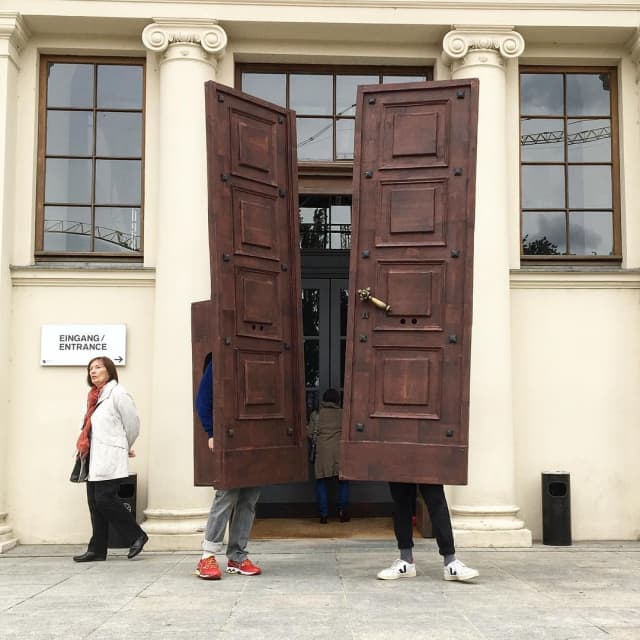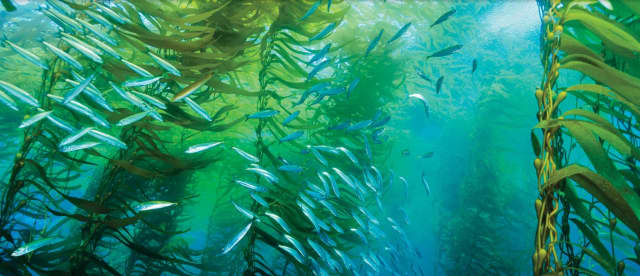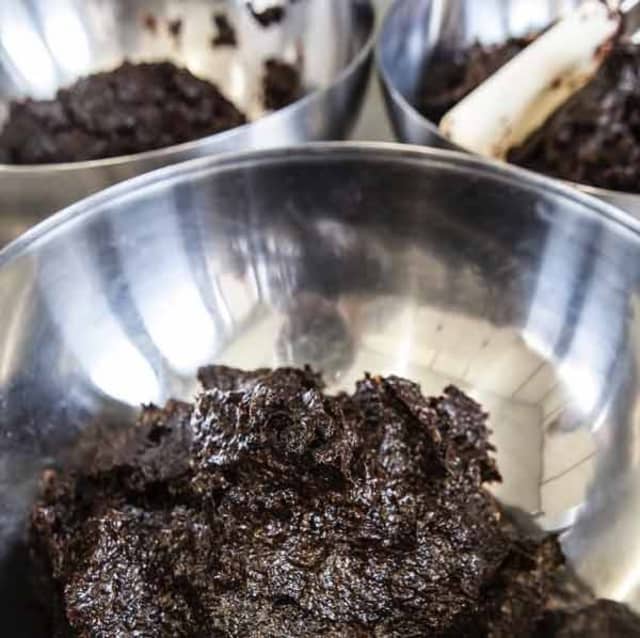Hinged view and Four deep ocean zones (watercolour and glacial ice)
Tanya Bonakdar Gallery at Frieze, London

Arctic Imagination: Minik Rosing, Prof. in geology, in conversation with Olafur Eliasson, New York City Library. Watch their conversation here: www.soe.tv
Hassna and her family do not have any access to energy. Due to living close to the equator, the sun sets around 6 pm year round. After the sun sets, Hassna’s family lives in pure darkness. Their only source of light is a small kerosene lamp or a sparse fireplace. Hassna and her family experience energy poverty. According to World Bank, 1.1 billion people worldwide are affected.
The Agenda 2030 was determined by the UN in New York in September 2015. It is a milestone for the future of our planet, specifying a sustainable transformation plan for the global economy, social life, and environment. And this plan has a direct impact on Hassna and her family. The Agenda 2030 defines 17 goals, the Sustainable Development Goals (SDGs) and among these goals lies Goal 7: the prevalence of affordable and clean energy. By 2030, all people on this planet should have access to affordable, reliable, and clean energy. There has never been such an ambitious goal before, and maintaining a sustainable energy supply globally is a complex task.
Since Hassna and her family do not have access to energy, they cannot read, work or do their homework after sunset. Kerosene lamps and fireplaces as sources of light do not provide enough light to see or work easily. This has an impact on school performance. The probability of dropping out of school without a qualification is quite high. Since Hassna and her family do not have access to clean energy, they are forced to use their kerosene lamp and their fireplace. The smoke and fumes from both are very harmful for the eyes and can cause eye and lung diseases.
Since Hassna’s home has no connection to a power supply, her family has to spend a lot of money for kerosene or on batteries for flashlights. In addition, they also need to pay for transportation to a shop to buy kerosene. Although Hassna is attending school, she doesn’t have access to the quality of education that others in the world may have access to, and doesn’t learn about the harmful effects of kerosene since her community relies on it. Due to the lack of awareness, Hassna and her family cannot improve their living conditions.
Learn more about Little Sun's work with the SDGs
Festival of Future Nows, Robert Lippok, What Is Dance? Hamburger Bahnhof, Berlin.
Visit Studio Kitchen Instagram for a look into the studio kitchen.
Loop Table (Infinity Table) was a participatory event at Festival of Future Nows, inviting the audience to create a modular table whilst eating. It was a collaboration between Studio Olafur Eliasson Kitchen, Raul Walch and art collective Xero
Launch of Little Sun Diamond, New York City.

Am 24. September wählen gehen! Poster von Wolfgang Tillmans. 7 Poster zur Bundestagswahl zum Download auf www.tillmans.co.uk


Tonight I'm launching my new solar lantern - Little Sun Diamond at MoMA Design Store in New York with my good friend Klaus Biesenbach - pushing sustainable and affordable energy for everyone. Get yours here: Little Sun Diamond
Festival of Future Nows is concluded at Hamburger Bahnhof and continues (is already) in the future. Here Malte Bartsch, Feuerwerk-automat

Festival of Future Nows: Everything Touches Everything, Nico Dockx
Fantastic opening of Festival of Future Nows. The festival continues throughout the weekend. Come join us at Hamburger Bahnhof. Here from the performance by Tomas Espinosa and Artur van Balen

Welcome, Not Welcome - by Alvaro Urbano. If you manage to get past the doors, you are warmly welcomed to Festival of Future Nows, tonight at Hamburgers Bahnhof, Berlin.
What Goes Down (And Must Come Up) by Euan Williams, one of the many artists participating in Festival of Future Nows opening tonight at Hamburger Bahnhof, Berlin. Come join us!
Tomorrow is going to be incredibly exciting! Festival of Future Nows opens at Hamburger Bahnhof in Berlin with more than 100 participating artists affiliated with Institut für Raumexperimente. Performances and interventions throughout the weekend. Join us tomorrow evening!

https://www.youtube.com/watch?v=75hgJCJXb0k
In collaboration with National Geographic, TBA21–Academy team discovered glowing red and green biofluorescent shells in Hawksbill turtles - a critically endangered species – during an expedition to the Solomon Islands in August.
Over the past two decades, the sea has slowly crept into human geography. Together with colleagues in the emergent field of critical ocean geography, we have been making the argument, time and again, that geography has historically been a land-locked and terra-centric project. Geography is earth-writing, and earthlessness has been taken very literally in shaping the spaces in which geographical study has taken place. As we have been arguing, new geographical knowledge can be unearthed when thinking from the sea [...] Subjects, objects, knowledges, and forces – seafarers, migrants, offshore protesters, fishermen (and women), naval officers, fish, ships, fossil fuels consumer goods laws, current, and infrastructures have all featured in the numerous publications that now pay attention to life at sea.
– Kimberley Peters and Philip Steinberg, p.28. Allan Sekula: OKEANOS, the sea-themed book on the late U.S. photographer published by TBA21. For his work Fish Story he spent 7 years photographic harbours and port cities around the world

Drawdown - 100 most substantive solutions to global warming: Marine Permaculture :
Reversing global warming by restoring the primary production of oceans, using kelp and other seaweeds. Primary production is the creation of organic compounds from carbon dioxide through photosynthesis. Oceans face a dire situation. They absorb half of the carbon dioxide recaptured from the atmosphere, which causes acidification, and over 90 percent of the heat from global warming. Ocean deserts are expanding. Marine life in subtropical waters can be saved with thousands of new kelp forests—what is called marine permaculture.The key technology involves marine permaculture arrays (MPAs), lightweight latticed structures roughly half a square mile in size, submerged 80 feet below sea level, to which kelp can attach. Attached buoys rise and fall with the waves, powering pumps that bring up colder, nutrient-rich waters from far below. Kelp soak up the nutrients and grow, establishing a trophic pyramid rich in plant and animal life.

Cooking with seaweed in the studio kitchen
Studio Kitchen Instagram
What are the alternative sites of modernity, we may then ask, connected to the oceanic space that we need to reclaim and can reclaim only if we finally give up the notion of the phenomenological void of the ocean? And finally: what does the relationship to water, to the riverine, the estuary, the oceanic bring us? What zones of relationality does it establish? How can water be seen as a hyperlink, as a connection, as a network of
connected thinking along geopolitical fault lines? What does the ocean want to tell us?
From Not just a Fish Story by Daniela Zyman, on Allan Sekula's essay-film The Forgotten Space p. 29 Allan Sekula: OKEANOS, the sea-themed book on the late U.S. photographer published by TBA21.